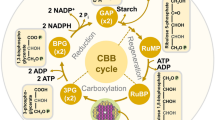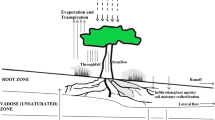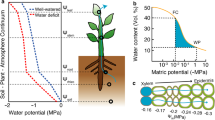Summary
A physical model, based on Darcy's law and an Ohm's-law analogy, was developed to show that water can move from a wetter side of a root system to a drier side or vice versa. In the model, a wick in the form of an inverted Y was used, with the two ends of the Y in separate beakers and the third end (stem) of the Y extending into the air. The left root, right root, and stem were about 6,5, and 4 cm long, respectively. The difference in total head (potential) between the left root and the right root was varied for different potentials applied to the stem. Experiments were done either in a darkened laboratory or with a sunlamp shining on the stem. The stem was thus exposed to low-evaporation (in the dark) or high-evaporation (with the sunlamp) conditions. Total heads (sum of head due to gravity and head due to pressure-other heads were negligible) and flows of water were calculated or measured for each part of the split-root system (left root, right root, crown, stem). The results showed that the direction and quantity of water flowing in each part of the system depended upon the total head for the stem, crown, and each half of the root (the flow could be up, down, left, or right), and that the gravity component of the total head was important in moving water down the plant when light intensity was low.
Similar content being viewed by others
References
Bormann F H 1957 Moisture transfer between plants through intertwined root systems. Plant Physiol. 32, 48–55.
Breazeale J.F 1930 Maintenance of moisture-equilibrium and nutrition of plants at and below the wilting percentage. Univ. Arizona Tech. Bull. 29, 137–177.
Hagan R M 1949 Autonomic diurnal cycles in the water relations of non-exuding detopped root systems. Plant Physiol. 24, 441–454.
Hunter A S and Kelley O J 1946 The extension of plant roots into dry soil. Plant Physiol. 21, 445–451.
Janes B E 1954 Absorption and loss of water by tomato leaves in a saturated atmosphere. Soil Sci. 78, 189–197.
Jensen R D, Taylor S A and Wiebe H H 1961 Negative transport and resistance to water flow through plants. Plant Physiol. 36, 633–638.
Kirkham D and Powers W L 1972 Advanced Soil Physics, John Wiley and Sons, Inc., New York, 534 p. (See pp. 46 and 74.)
Kirkham M B 1980 Movement of cadmium and water in split-root wheat plants. Soil Sci. 129, 339–344.
Klute A 1965 Laboratory measurement of hydraulic conductivity of saturated soil.In Methods of Soil Analysis. Part 1. Physical and Mineralogical Properties, Including Statistics of Measurement and Sampling. Ed. C A Black pp 210–221. Amer. Soc. Agronomy, Madison, Wisconsin. (See p. 217.)
Kramer P J 1969 Plant and Soil Water Relationships: A Modern Synthesis. McGraw-Hill Book Co., New York, 482 p. (See pp. 117 and 167.)
Luthin J N 1974 Drainage analogues.In Drainage for Agriculture. Ed. J van Schilfgaarde. pp 517–536. Am. Soc. Agronomy, Madison, Wisconsin. (See p. 518.)
Magistad O C and Breazeale J F 1929 Plant and soil relations at and below the wilting percentage. Univ. Arizona Tech. Bull. 25, 1–36.
Molz F J and Peterson C M 1976 Water transport from roots to soil. Agron. J. 68, 901–904.
Müller-Stoll W R 1965 The problems of water outflow from roots.In Water Stress in Plants. Ed. B Slavík. pp 21–29. Dr W. Junk Publishers, The Hague.
Salisbury F B and Ross C W 1978 Plant Physiology. Second ed. Wadsworth Publishing Co., Inc., Belmont, California, 436 p. (see p. 56.)
Selim H M and Kirkham D 1974 Unsteady state two-dimensional water content distribution and wetting fronts in soils. Geoderma 11, 259–274.
Slatyer R O 1956 Absorption of water from atmospheres of different humidity and its transport through plants. Aust. J. Biol. Sci. 9, 552–558.
Slavíková J 1967 Compensation of root suction force within a single root system. Biol. Plant. 9, 20–27.
van Bavel C H M and Ahmed J 1976 Dynamic simulation of water depletion in the root zone. Ecol. Modelling 2, 189–212.
Volk G M 1947 Significance of moisture translocation from soil zones of low moisture tension to zones of high moisture tension by plant roots. J. Am. Soc. Agron. 39, 93–106.
Whisler F D, Klute A and Millington R J 1968 Analysis of steady-state evapotranspiration from a soil column. Soil Sci. Soc. Am. Proc. 32, 167–174.
Wiersma D and Veihmeyer F J 1954 Absence of water exudation from roots of plants grown in an atmosphere of high humidity. Soil Sci. 78, 33–36.
Author information
Authors and Affiliations
Rights and permissions
About this article
Cite this article
Kirkham, M.B. Physical model of water in a split-root system. Plant Soil 75, 153–168 (1983). https://doi.org/10.1007/BF02375562
Received:
Revised:
Issue Date:
DOI: https://doi.org/10.1007/BF02375562




